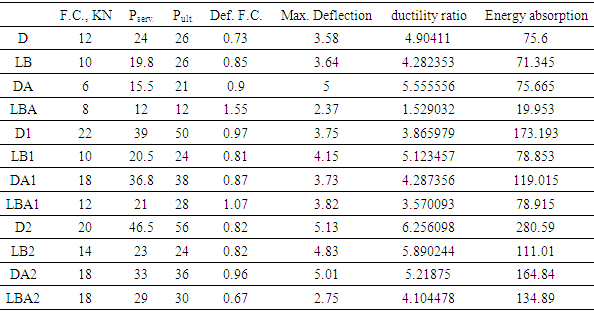-
Paper Information
- Paper Submission
-
Journal Information
- About This Journal
- Editorial Board
- Current Issue
- Archive
- Author Guidelines
- Contact Us
Journal of Civil Engineering Research
p-ISSN: 2163-2316 e-ISSN: 2163-2340
2021; 11(2): 29-45
doi:10.5923/j.jce.20211102.01
Received: Jun. 26, 2021; Accepted: Jul. 16, 2021; Published: Jul. 26, 2021

Durability of Lightweight Self-Curing Concrete
Shaheen Y. B. I. 1, Bashandy A. A. 1, Elsaidy A. A. 2
1Professors at Civil Engineering Department, Faculty of Engineering, Menoufia University, Egypt
2Civil Engineer, M.Sc. Candidate
Correspondence to: Elsaidy A. A. , Civil Engineer, M.Sc. Candidate.
| Email: |  |
Copyright © 2021 The Author(s). Published by Scientific & Academic Publishing.
This work is licensed under the Creative Commons Attribution International License (CC BY).
http://creativecommons.org/licenses/by/4.0/

This paper presents the major causes of deterioration and discusses the factors, which can improve the durability of concrete structures. This paper also presents the results of an extensive experimental investigation for the reuse of industrial by product materials such as blast furnace slag (BFS) and silica fume (SF) in producing high performance concrete. Producing of high strength concrete has a worthy priority field of study worldwide, their production is largely expanded the last two decades. Potential applications of light weight high strength concrete are in producing thin durable sections and in strengthening and repairing defaulted structures. It is shown that it is possible to develop a concrete matrix of high strength and excellent durability by taking the advantage of the interactions of cementitious system and the Portland-cement slag system is shown to offer a good example of this nature. However, development of light weight strength and performance concrete will be necessary to protect the concrete from aggressive and unfriendly environmental and climatic conditions. Lightweight concrete can significantly reduce a dead load of structural concrete elements compared to normal-weight concrete. Self-curing concrete is one of the innovative concretes that can be cured without using conventional curing regimes. Lightweight concrete is made from lightweight coarse aggregates instead of natural coarse aggregates. It has gained popularity due to its lower density and superior thermal insulation properties. In this investigation, the durability of lightweight self-curing concrete under the attack of sulfates and chlorides was studied. The effects of sulfates (as 20% concentrated sodium sulfates solution) on compressive, splitting tensile and flexure strengths after different ages (2, 4, and 6 months) were studied. The effects of chloride attack (as 20% concentrated sodium chloride solution) were studied on bond and flexure strengths after two ages (2 and 4 months). Also, the flexure behavior of the lightweight aggregate self-curing reinforced concrete beams is studied under a four-point load system before and after chloride attack. Test results indicated that dolomite then crushed concrete followed by Addibor can be used as coarse aggregates for structural self-curing concrete under chlorides or sulfates Using lightweight aggregates (Addipor-55) or lightweight bricks as a replacement of dolomite can be used to produces lightweight self-curing concrete with satisfied durability characteristics under chlorides or sulfate attack.
Keywords: Durability, Self-curing, Lightweight, Polyethylene Glycol, Addipor, Concrete
Cite this paper: Shaheen Y. B. I. , Bashandy A. A. , Elsaidy A. A. , Durability of Lightweight Self-Curing Concrete, Journal of Civil Engineering Research, Vol. 11 No. 2, 2021, pp. 29-45. doi: 10.5923/j.jce.20211102.01.
Article Outline
1. Introduction
- Shaheen Y.B.I., [1]. arrived that irrespective of the type of replacement material, there was a good enhancement in compressive and flexural strengths at all replacement levels comparable to those of the control test specimens. The development of high performance concrete can be used in a variety of applications due to high durability, chemical resistance, and long term strength. Significant environmental benefits can be also realized from this useful consumption of such industrial waste materials. A variety of methods by which the durability of concrete can be enhanced is available to the designer. Options include increasing the cover to the reinforcement and reducing the permeability of the concrete by control of the water/cement ratio, this could be achieved by careful curing or by the used of additives or cement replacements. Most of these methods add little to the construction cost. It is shown that it is possible to develop a concrete matrix of high strength and excellent durability through design process and best selection of materials, concrete fabrication, structural calculations, construction, and in-situ performance. Development of strength and a highly refined pore structure are time dependent phenomena, and in extreme environments, it may will be necessary to protect the concrete from its surrounding, to enable it to achieve its full potential for strength and durability.Shaheen Y.B.I [2] carried out tests emphasized the effectiveness of utilizing fly ash supplementation of cement in concrete. 50% replacement of cement with PFA gave approximately equal compressive strength at 28 days and higher workability than a comparable mix produced with cement only. The cube compressive strength at one year was found to be 1.63 x the strength at 28 days. The lower the water to cement cementitious ratio; the greater the strength and durability and impermeability of finished concrete.Shaheen Y.B.I [3] arrived that the replacement of cement by silica fume and sedition of superplasticizer increases the strength of concrete. Concrete containing silica fume as a partial replacement for cement exhibits an increased compressive strength at later ages due to the continued hydration and strength gain development. The optimum limit of partial replacement of cement with silica fume was found to be 15-20% in this investigation. Curing regime has a dominant effect in compressive strength increase of silica fume concrete with optimum limits.These limits were found to be 30% and 55# increase of compressive strength of water curing specimens having 5-15% SF and 20-25$SF respectively. Initial and type of curing was found to be essential for SF concrete. The use of industrial by product material (SF) with cement; the higher strength development; the durable construction; the mre energy saving. The developed high strength concrete can be used in a variety of strengthening and repairing situations for high durability and long term strengths.Fahmy E.H. and Shaheen Y.B.I, etl [4] carried 0utextensive experimental program to investigate the viability of using expanded polystyrene (EPS) wastes for the developing lightweight mortar mixes for the production of lightweight thermally efficient solid brick was conducted. The Effect of the using EPS on the mechanical and thermal properties of the lightweight mortar mixes and solid bricks was investigated.In recent years, the demand for structural lightweight concrete increased in several applications of modern constructions [1]. This was owing to many advantages such as lower density results in a significant benefit in terms of load-bearing elements of smaller cross-sections and reduction in the size of the foundations [2,3]. The aggregates considered the former of concrete, which is, actuates about 75% of concrete volume. Using lightweight aggregate (LWA) in the concrete industry contributes to producing lightweight concrete (LWC). LWA is broadly classified into two types; natural (pumice, diatomite, volcanic cinders, etc.) and artificial (perlite, expanded shale, clay, slate, sintered PFA, etc.). Lightweight concrete can be produced easily by utilizing lightweight aggregate such as pumice or perlite aggregate [4-9]. Also, the lightweight concrete can be obtained by introducing air through the proprietary foam process which enables one to control density and strength precisely. Normal concrete has a density of 2,400 kg/m3 while densities range from 1,600-1,800 down to 300 or by using lightweight aggregates. Compressive strength decreased due to the decrease in the concrete densities. Generally, it has more than excellent thermal and sound insulating properties, a good fire rating concrete is non-combustible, and features cost savings through construction speed and ease of handling [10]. Concrete curing is one of the most important processes in achieving the desired properties of concrete. Self-curing concrete represents a new trend in concrete curing methods. The basic concept of this technology is to provide water for concrete curing so that it can continue the curing process on its own. This is done by embedding the water inside the materials used to make concrete or/and reducing the water evaporation from the concrete and hence increase the water retention capacity of concrete. This technology can reduce but not completely remove the drying shrinkage. Furthermore, compressive strength will be enhanced with the reduced shrinkage arising from water evaporation, making it ideal for concrete placing without any external curing [10-17]. Shrinkage-reducing admixture (SRA), based on the use of poly-glycol products in the concrete mixes, has been more recently suggested to reduce the risk of cracking in concrete structure caused by drying shrinkage [19,20]. The mechanism of this admixture is based on a physical change (reduction of the surface tension of the mixing water) rather than on a reduction of water evaporation [19,21].Durability is defined as the capability of concrete to resist deterioration from an external environment [22,23]. Light aggregates are more porous compared to natural aggregates [24]. Increased porosity of aggregates used may lower the bond strength between the cement paste and the aggregate (interfacial transition zone). Thereby leading to a loss in concrete strength, an increase in ion penetrability, and presumably a reduction in corrosion resistance [2,25,26].Internal curing was investigated as a potential method to improve the durability of light aggregate concrete (LAC) [15]. Coarse porous aggregates such as LECA and lightweight crushed brick have potential as an internal curing agent due to their high absorption capacity and low cost [7,24]. The utilization of crushed light concrete aggregates (CLCA) as an internal curing agent resulted in a limited reduction in autogenous shrinkage of high-performance mixtures [27,28].In this research, the durability of lightweight self-curing (LW-SC) concrete is studied.
2. Research Significance
- The weight of concrete causes an increase in the concrete dead loads so, lightweight concrete may be a solution. Curing concrete after cast in desert areas and such places of low water may be a problem so using self-curing concrete is a suggestion. Combining the two types produces the benefits of both. Long-term behavior is essential to be studied. This research aims to study the durability of Lightweight self-curing concrete (LW-SC). The durability is studied under the attack of sulfates and chlorides (Na2SO4 and NaCl with a concentration of 20%). The sulfate effects on the main hardened concrete properties were studied for samples after 2, 4, and 6 months of the attack. The chloride effects on standard cubes with embedded rebar's and reinforced concrete beam samples after 1, 2, and 4 months of the attack were studied. Beam samples immersed in sodium chloride solution (with a 20% concentration degree and connected to an electrical cell to accelerate the chloride effects). The flexure behavior of the LW-SC reinforced concrete beams is studied. The importance of this research is based on current research needs to know the data addressing the long-term behavior of lightweight self-curing concrete. This research provides data for the engineers concerning the influence of using self-curing concrete cast using lightweight in aggressive conditions, which contains chloride and sulfate ions.
3. Materials and Test Specimens
- All tests in this research are carried out in the Construction Materials Laboratory in the Civil Engineering Department, Faculty of Engineering, Menoufia University. The materials used, design of test specimens, and testing procedures are discussed in the following sections. The conducted experimental program is shown in Fig. (1).
3.1. Materials
- The cement used is the ordinary Portland cement CEM I 42.5 N from the Suez cement factory. It satisfies the Egyptian Standard Specification for cement E.S.S. 4756-1/2009 [29]. Drinkable clean water, fresh and free from impurities is used for mixing according to the Egyptian code of practice [30]. The fine aggregate used is the natural siliceous sand that satisfies the standards for concrete aggregates [31,32]. It is clean and nearly free from impurities with a specific gravity of 2.6 and a fineness modulus of 2.61. Its mechanical properties are shown in Table (1) while its grading is shown in Table (2). Two types of aggregates are used, natural and lightweight aggregates. The coarse aggregate used is crushed dolomite with a maximum nominal size of 20 mm and lightweight aggregate (lightweight brick and Addipor) as shown in Tables (3) and (4). It satisfies the ASTM C-33 [31]. The shape of these particles is irregular and angular with a very low percentage of flat particles. Two types of steel rebars are used, mild and high tensile steel rebars. Mild steel bars of 8 mm diameter were used for stirrups with a yield strength of 240 MPa and had a tensile strength of 350 MPa. Its chemical and physical characteristics satisfy the Egyptian Standard Specification E.S.S. 262/2011 [33]. High tensile deformed steel bars produced from the Ezz Al Dekhila Steel at Alexandria were used. Deformed high tensile steel bars of grade 360/520 with a nominal diameter of 12 mm and a length of 160 mm were used as embedded reinforcement with proof stress of 360 MPa. Steel bars of diameter 10 mm were used in reinforcing the concrete beams as shown in Fig. (4). Their yield stress was 380 MPa and their tensile strength was 570 MPa. Its chemical and physical characteristics satisfy E.S.S. 262/2011 [33].
|
|
|
|
 | Table 5. Technical information about Polyethylene Glycol 400 "PEG400" used (as provided by the manufacturer) |
3.2. Concrete Mixtures and Tested Samples
- Concrete mixes were chosen based on the previous researches [34,35]. Table (6) shows the proportions of lightweight self-curing LW-SC concrete mixes used to study the effect of sulfates and chlorides on the durability of LW-SC concrete.
 | Table 6. Proportions of concrete mixes used |
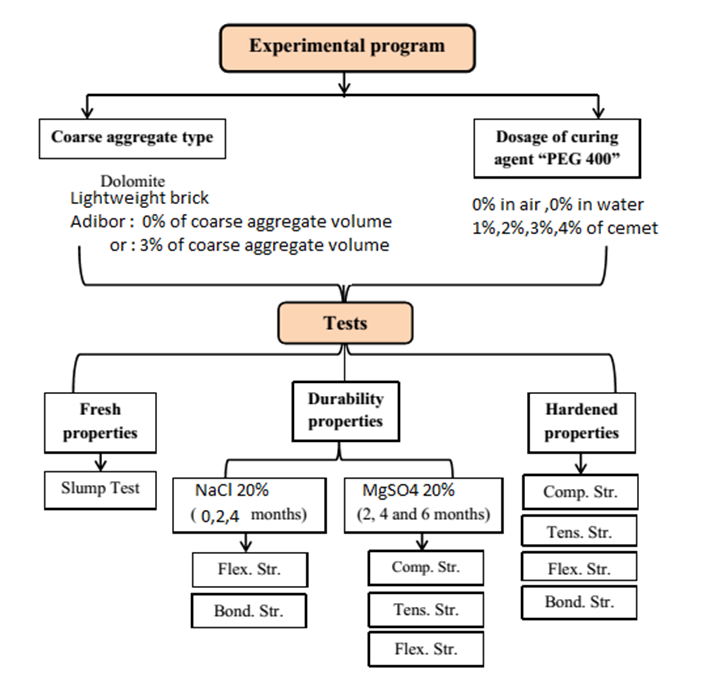 | Figure 1. Experimental Program |
 12 mm to determine the bond strength. Reinforced concrete beams having the dimensions of 100x150x1000 mm were cast to study the flexure behavior of beams as shown in Fig. (2). Each beam was reinforced with 2
12 mm to determine the bond strength. Reinforced concrete beams having the dimensions of 100x150x1000 mm were cast to study the flexure behavior of beams as shown in Fig. (2). Each beam was reinforced with 2 10 mm of high strength steel (St. 52) as main lower reinforcement and 2Ø8 mm of mild steel (St. 37) as stirrup hunger with stirrups of 7Ø8/m' as shown in Fig. (2).
10 mm of high strength steel (St. 52) as main lower reinforcement and 2Ø8 mm of mild steel (St. 37) as stirrup hunger with stirrups of 7Ø8/m' as shown in Fig. (2).  | Figure 2. Dimensions, reinforcement, and the loading method for beam samples |
3.3. Sulfate Attack Simulation
- To simulate the sulfate attack, the samples were immersed in 20% concentration Na2SO4 solution for periods up to 6 months. All samples are immersed, then tested after 2, 4, and 6 months. Results were compared to control samples. The tested samples are standard cubes, cylinders, and prisms to obtain compressive, splitting tensile, and flexure strength values. The effects of sulfate attack are obtained in terms of compressive, splitting tensile, and flexure strengths.
3.4. Chloride Attack Simulation
- In this research, the simulation of chlorides attack was performed by immersing the samples in 20% concentration NaCl solution for 2 and 4 months. Tested samples are standard cubes with embedded rebars (as discussed before) and reinforced concrete beam samples as shown in Fig. (2). An electric cell was used to accelerate the corrosion process as shown in Fig. (3). Steel rebars are joined to the electrical cell as shown in Fig. (4). The embedded rebars are connected to the positive anode. Steel peace connected to the negative cathode then immersed in the same solution as shown in Fig. (4). Ions leave the surface of the steel reinforcing bars and pass into the water. Fresh atoms ionize to replace the dissolved ions. The steel rebar corrodes. The electrons released by the ionized iron atoms flow through the connecting wire to the cathode bar. At the cathode bar, the released electrons, which have built up, attract positive hydrogen ions. The hydrogen ions are adsorbed onto the bar’s surface and then combine with the electrons to form hydrogen gas. The gas bubbles up and leaves the solution. The cathode bar does not corrode. It simply provides a surface where hydrogen ions can meet and combine with electrons [33,35].
 | Figure 3. The electrical circuit accelerates the corrosion at cubes and beams |
 | Figure 4. Four-point load flexure tests |
3.5. Testing of Samples
- Standard samples were tested by using compressive strength testing machine of 200kN capacity to obtain their compressive, splitting tensile, and bond strengths. To obtain flexure strength, the beam specimens were placed on a flexure-testing machine of a capacity of 100 KN as shown in Figs. (5) and (6). Two deflect meter dial gauges were used (at the midpoint of the lower surface) to determine the deflections of the reinforced "LW-SC" concrete beams. Beams were tested and the deflection values, as well as compressive and tensile strain values, were determined. Initial crack load and failure loads were recorded and crack patterns are sketched.
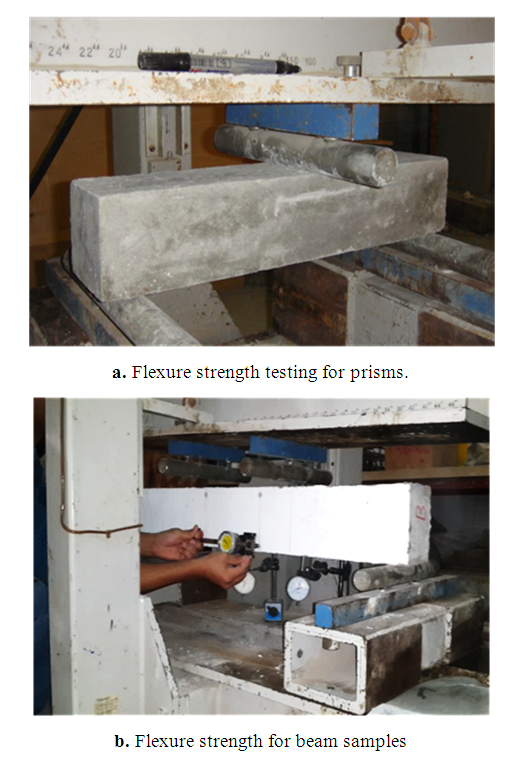 | Figure 5. Flexure strength test for prisms and beams |
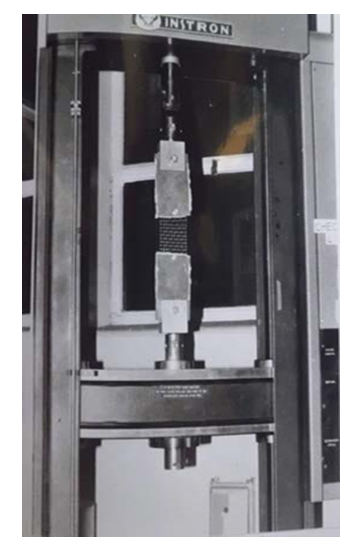 | Figure 6. Tensile steel meshes, (Swamy and Shaheen, 1990) |
3.6. Reinforcing Steel Bars
- High tensile deformed steel bars of diameter 12mm were used to reinforce the control beams and the concrete core of the test specimens incorporating U-shaped permanent ferrocement forms. Tensile tests were performed on three samples of the bars. The average test results of the three samples showed the proof stress and ultimate strength of the material were 641N/mm2 and 723N/mm2 respectively. The stress-strain relationship for the reinforcing steel bars are shown in Figure 35.Mild steel stirrups of diameter 8 mm were used as shear reinforcement for the control beam. The material has nominal yield stress of 240 N/mm2. Tensile test was not performed on this type of steel.
4. Test Results and Discussions
4.1. Effect of Using Chemical Curing Agent "Peg 400"
- The main studied mechanical properties are compressive, splitting tensile, flexural, and bond strengths. The results are shown in Table (7) and Figs. (7) to (10). They show the relationship between the dosages of polyethylene glycol 400 "PEG 400" as a chemical curing agent and compressive strength values after 28 days.
|
 | Figure 7. Compressive strength after 28 Days at different PEG ratios |
 | Figure 8. Splitting tensile strength after 28 Days at different PEG ratios |
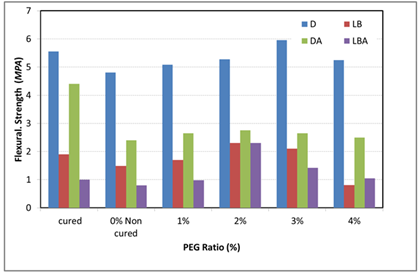 | Figure 9. Flexural strength after 28 Days at different PEG ratios |
 | Figure 10. Bond strength after 28 Days at different PEG ratios |
4.2. Durability of LW-SC Concrete
- The hardened concrete properties of the LW-SC concrete mixes are studied in terms of compressive, splitting tensile, flexure, and bond strengths. Results are shown in Table (8) and Figures (11) to (14).
|
 | Figure 11. Compressive strength of concrete samples after different periods of sulfate attack |
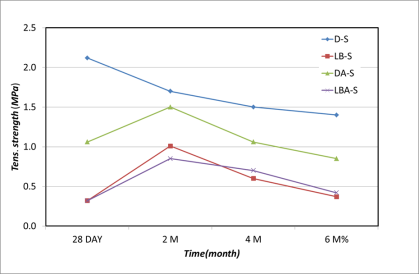 | Figure 12. The splitting tensile strength of concrete samples after different periods of sulfate attack |
 | Figure 13. Flexural strength of concrete samples after different periods of sulfate attack |
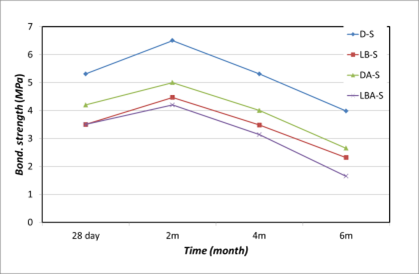 | Figure 14. Bond strength of concrete samples after different periods of sulfate attack |
4.2.1. Durability of LW-SC Concrete Under Sulfates Attack
- The hardened concrete properties of the LW-SC concrete mixes are studied under the effect of sulfates attack after different ages of 2, 4, and 6 months. The samples were immersed in a sodium sulfate solution (with 20% concentration).The results of the compressive, splitting tensile, flexure, and bond strength tests due to the attack of sulfates are shown in Table (8) and Figures (11) to (14).Figure (11) shows the effect of sulfate attack on the compressive strength of the tested samples after different exposure periods to sulfate attack. The values of the compressive strength increase under the effect of sulfates at early ages. That may because the attack products are deposited in the pore spaces of concrete. After 2 months, values started to decrease and the damage rate of concrete has been accelerated greatly. In the case of the self-curing concrete using dolomite ("D" group), the compressive strength decreased by 2.04%, 23.8%, and 44.2% after 2, 4, and 6 months of the attack, respectively compared to the control mix "D-S0". In the case of the self-curing concrete made from Light brick (''LB'' group), the compressive strength increased by about 46.6% after 2 months, then decreased by 5% and 14% after 4 and 6 months, respectively compared to the control mix "LB-S0". In the case of the ''DA'' group, the compressive strength increased by about 18.1% after 2 months, then decrease by 4.7% and 29.5% after 4 and 6 months, respectively compared to the control mix "DA-S0". The lower value of obtained compressive strength of samples cast using lightweight bricks compared to those cast using dolomite is thought to be due to an excessive amount of voids. In the case of the ''LBA'' group, the compressive strength decreased by about 6.6% after 2 months, respectively, then it still decreases by 36.6% and 46.6% after 4 and 6 months, respectively compared to the control mix "LBA-S0". The loss of its compressive strength compared to dolomite may be due to the higher number of voids and the higher permeability of light brick, which leads to a greater area of material being attacked by the sulfates. The results are in good agreement with previous researchers [27].Figure (12) shows the tensile splitting strength values after different exposing times to sulfate attack. The results are in good agreement with those of compressive strength. In the case of the "D" group, the tensile splitting strength decreased by about 19.81%, 29.7%, and 34.9% after 2, 4, and 6 months, respectively compared to the control mix "D-S0". In the case of the ''LB'' group, the tensile splitting strength increased by about 115.6% after 2 months, then decreased by about 72% and 15.6% after 4 and 6 months compared to the control mix "LB-S0". In the case of the ''DA'' group, the tensile splitting strength increased by about 40.6% after 2 months, then decreased by about 4% and 19.8% after 4 and 6 months compared to the control mix "DA-S0". For the ''LBA'' group, the tensile splitting strength increased by about 165.6% after 2 months, respectively, then it decreased by about 118.8% and 31.2% after 4 and 6 months compared to the control mix "LBA-S0".Figure (13) shows the flexure strength values at different times under the effect of sulfates. The flexure strength values decrease under the effect of sulfates (in the range of this study). For the "D" group, the flexure strength decreased by about 27.9%, 92%, and 94.3% after 2, 4, and 6 months, respectively compared to the control mix "D-S0". In the ''LB'' group, the flexure strength decreased by about 26%, 91.7%, and 93.5% after 2, 4, and 6 months, respectively compared to the control mix "LB-S0". For the ''DA'' group, the flexure strength decreased by about 37.7%, 86%, and 90% after 2, 4, and 6 months, respectively compared to the control mix "DA-S0". At the ''LBA'' group, the flexure strength decreased by about 39%, 92%, and 93.9% after 2, 4, and 6 months, respectively compared to the control mix "LBA-S0". The results are satisfying previous researches.Figure (14) shows the bond strength values at different times under the effect of sulfates. The bond strength values increased under the effect of sulfates after 2 months, then start to decrease after 4 and 6 months (in the range of this study). For the "D" group, the bond strength increased by about 22.4% after 2 months, then decreased by about 4% and 25% after 4 and 6 months compared to the control mix "D-S0". For the ''LB'' group, the bond strength increased by about 27.7% after 2 months, then decreased by about 1% and 33.7% after 4 and 6 months compared to the control mix "LB-S0". In the ''DA'' group, the bond strength increased by about 19% after 2 months, then decrease by 4.8% and 36.9% after 4 and 6 months compared to the control mix "DA-S0". For the ''LBA'' group, the bond strength increased by about 20% after 2 months, then decrease by 10.3% and 52.9% after 4 and 6 months compared to the control mix "LBA-S0".
4.3. Durability of LW-SC Concrete under Chlorides Attack
- The bond strength of the LWC-SC concrete mixes and the flexure behavior of the LW-SC reinforced concrete beams were studied under the effect of chloride attack for different exposure periods 2 and 4 months. The chloride effect is accelerated by using an electrical cell with a high dosage of chlorides (20% concentration as about 50 times of allowable dosage at E.C.P. 203/2017 [30]).
4.3.1. Effects of Chlorides on Compressive Strength of LW-SC
- Table (9) and Fig. (15) show the compressive strength values at different periods under the effect of chloride attacks. Based on Fig. (15), the compressive strength values decrease overtime under the effect of chlorides. In the case of group "D", the bond strength decreased by about 14.3% and 38.8% after 2 and 4 months, respectively. That may because the penetrations of chloride ions to the protective oxide film then leave the steel vulnerable to corrosion. Due to the formation of corrosion, the bond between the concrete and reinforcement lost. For group ''LB'', the compressive strength decreased by about 10% and 44% after 2 and 4 months, respectively. In the case of the ''DA'' group, the compressive strength decreased by about 20% and 34.3% after 2 and 4 months, respectively. In the case of the self-curing concrete cast using the ''LBA'' group, the compressive strength decreased by about 34% and 80% after 2 and 4 months, respectively.
|
 | Figure 15. Compressive strength of concrete samples ab65g5+6fter different periods of chloride attack |
4.3.2. Effects of Chlorides on Bond Strength of LW-SC
- Table (9) and Fig. (16) show the bond strength values at different periods under the effect of chloride attacks. Based on Fig. (16), the bond strength values increased under the effect of chlorides after 2 months, then start to decrease after 4 months. For the "D" group, the bond strength increased by about 2.5% after 2 months, then start to decrease by about 7.9% after 4 months. That may because the penetrations of chloride ions to the protective oxide film then leave the steel vulnerable to corrosion. Due to the formation of corrosion the bond between the concrete and reinforcement lost. For the ''LB'' group, the bond strength decreased by about 11.4% and 54.3% after 2 and 4 months, respectively. In the ''DA'' group, the bond strength increased by about 10.4% after 2, then it decreases by about 37% after 4 months, respectively. For the ''LBA'' group, the bond strength decreased by about 24.3% and 48.6% after 2 and 4 months, respectively.
 | Figure 16. Bond strength of concrete samples after different periods of chloride attack |
4.3.3. Effects of Chlorides on Flexure Behavior of LW-SC Reinforced Concrete Beams
- Beams were tested using a four-point load flexure test as shown in Figs. (5), (6b), (23) and (24). Beam failures can be caused by different factors and reasons, and the most common causes of beam failures are bending stress and shear stress.
4.3.3.1. Initial Cracking and Ultimate Loads
- Initial cracking and ultimate loads of all tested beams are listed in Table (10) and Fig. (24). The initial cracking and ultimate loads of the "LW-SC" reinforced concrete beams decrease overtime under the effect of chlorides attack.
|
4.3.3.2. Load-Deflection Curves
- The deflection values at mid-span of self-curing reinforced concrete beams "DC", "LBC", "DAC", and ''LBAC' are shown in Figs. (17) to (22).The obtained results for the control group (tested after 28 days without chlorides effect) are shown in Figs. (17) to (22). Based on Table (11), the ductility of the reinforced self-curing beams cast using dolomite "DC-0" is lower than both reinforce self-curing beams cast using "LBC-0", ''DAC-0" and "LBAC-0" beams by about 12.7%, 13.2%, and 68.8%, respectively. After immersing in accelerated chloride attack for one month, the ductility of the reinforced self-curing beams cast using dolomite "DC-1" is lower than both the reinforced self-curing beams cast using "LBC-1", the reinforced self-curing beams cast using "DAC-1" and ''LBAC-1'' by about 32.5%, 10.9%, and 7.65%, respectively. After 2 months, the ductility of beams "DC-2", "LBC-2", "DAC-2" and ''LBAC-2'' by about 5.8%, 16.6%, and 34.4%, respectively. That may because of the weakness of light bricks as coarse aggregate compared to dolomite.
|
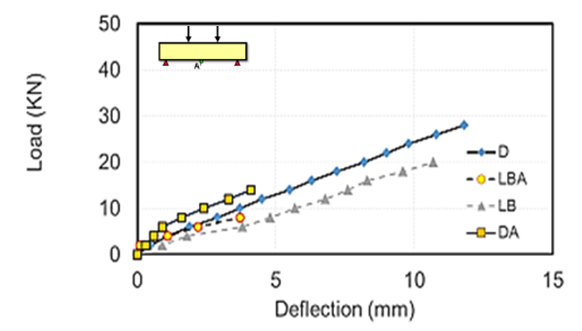 | Figure 17. Load-deflection curves at mid-span of LW-SC reinforced concrete beams after 28 days as control samples |
 | Figure 18. Load-deflection curves at mid-span of LW-SC reinforced concrete beams after 28 days as control samples |
 | Figure 19. Load-Deflection Curves at Mid Span of LW Concrete Beams after one month |
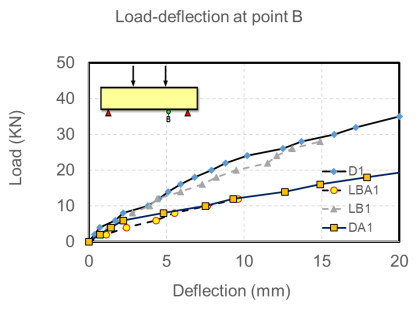 | Figure 20. Load-Deflection Curves at Mid Span of LW Concrete Beams after one month |
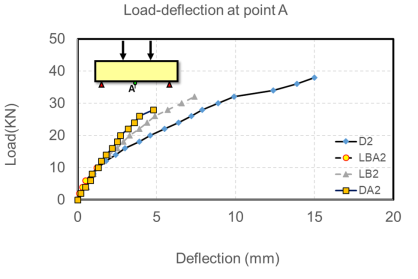 | Figure 21. Load-Deflection Curves at Mid Span of LW Concrete Beams after two months |
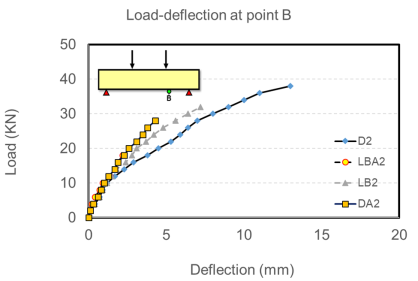 | Figure 22. Load-Deflection Curves at Mid Span of LW Concrete Beams after two months |
 | Figure 23. The ultimate load of tested beams |
 | Figure 24. The first crack of tested beams |
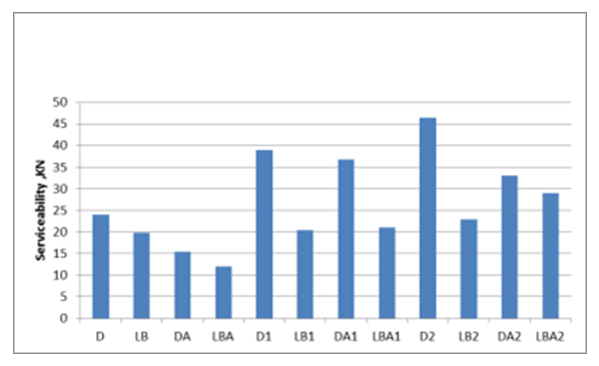 | Figure 25. Serviceability load of tested beams |
 | Figure 26. Energy absorption of tested beams |
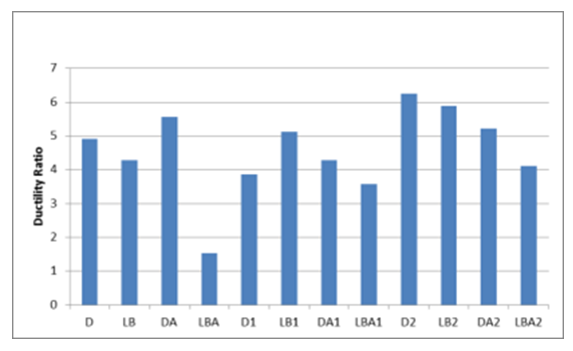 | Figure 27. Ductility ratio of tested beams |
4.3.3.3. Load-Strain Curves
- A- Strain at Bottom "Tensile Strain"The results of load-strain curves at the bottom "tensile strain" of beams at different ages for "DC", "LBC", ''DAC'' and "LBAC" reinforced concrete beams are shown in Figs. (28) to (30).
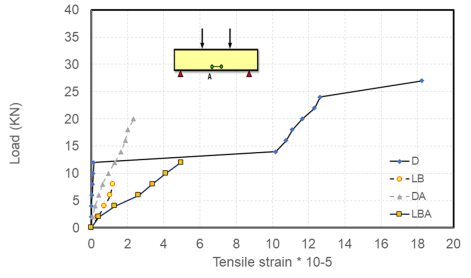 | Figure 28. Load-tensile strain curves of “LW-SC” reinforced concrete beams for control samples |
 | Figure 29. Load-tensile strain curves of “LW-SC” reinforced concrete beams after 1 month of accelerated effects of chlorides |
 | Figure 30. Load-tensile strain curves of “LW-SC” reinforced concrete beams after 2 months of accelerated effects of chlorides |
 | Figure 31. Load-compressive strain curves of “LW-SC” reinforced concrete beams for control samples |
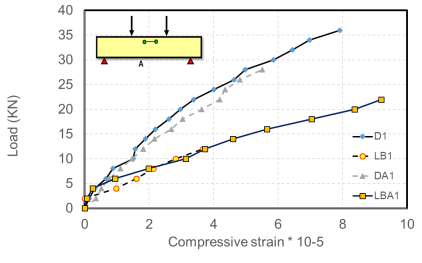 | Figure 32. Load-compressive strain curves of “LW-SC” reinforced concrete beams after 2 months |
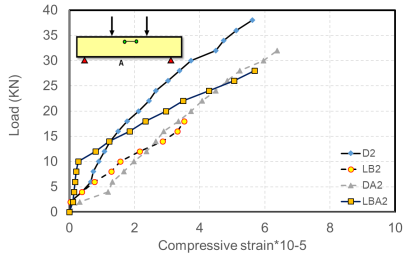 | Figure 33. Load-compressive strain curves of “LW-SC” reinforced concrete beams after 2 months |
4.3.3.4. Crack Pattern
- The crack patterns recorded are then illustrated at each load increment up to failure then photographed. The number of cracks increased during the loading stages. Figures from (35) to (37) show the crack patterns for "DC", "LBC", "DAC", and ''LBAC' reinforced concrete beams at different loading stages after different periods (at 28 days as control samples, 1, and 2 months).
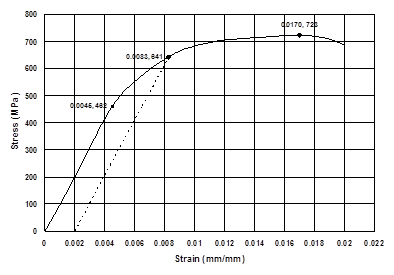 | Figure 34. Stress-strain relationship for the reinforcing steel bars |
 | Figure 35. Crack patterns for self-curing beams cast using chloride attack after 28 days |
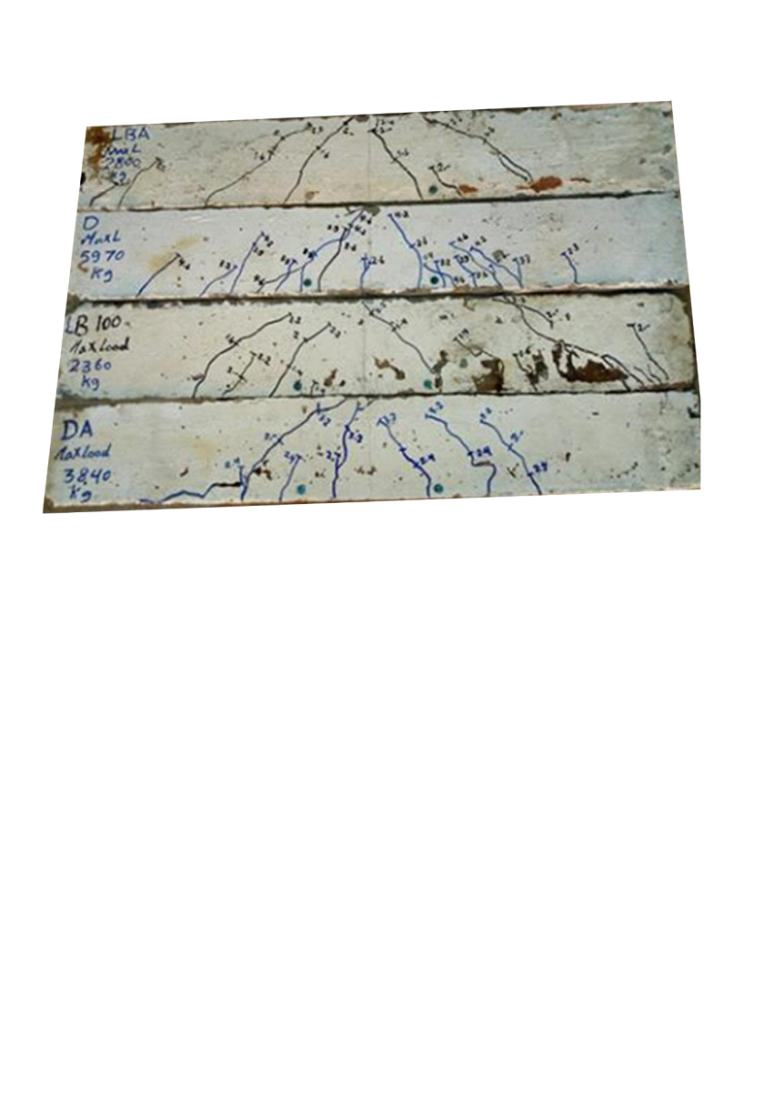 | Figure 36. Crack patterns for self-curing beams cast using chloride attack after 2 months |
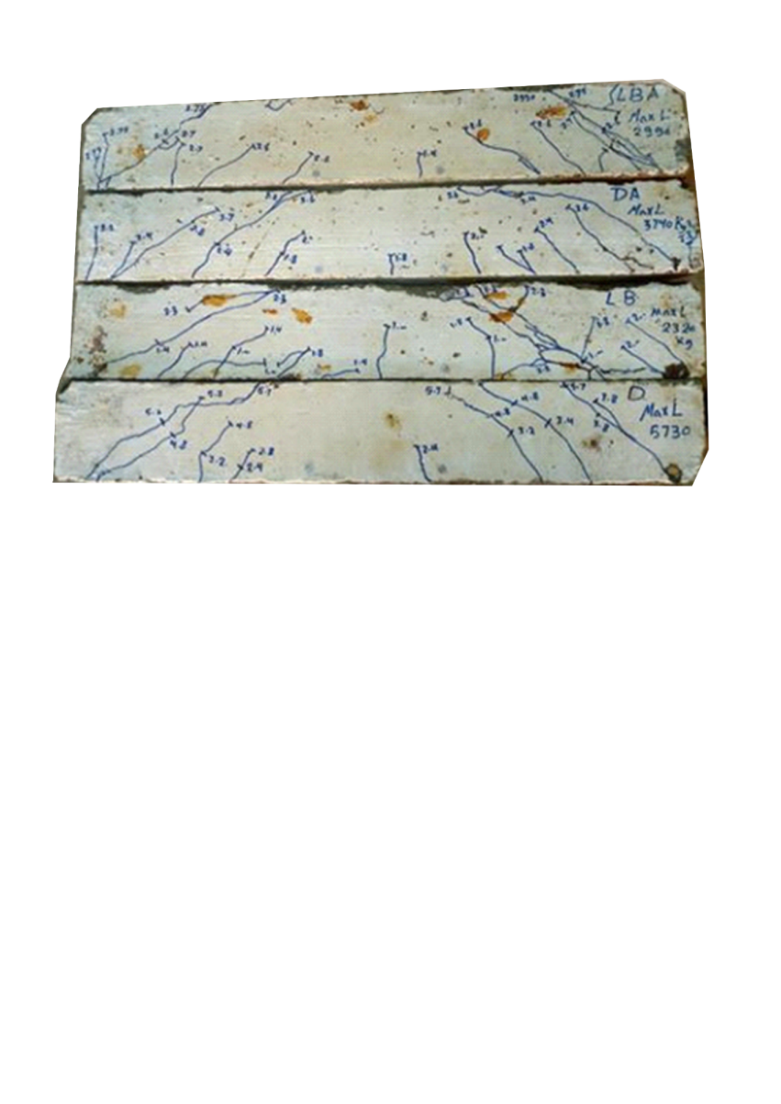 | Figure 37. Crack patterns for self-curing beams cast using chloride attack after 4 months |
5. Conclusions
- In this research, a series of experiments have been performed to investigate the behavior and the properties of lightweight concrete "LWC". Based on the experimental results presented in this study, the following conclusions could be drawn as follows:1. For lightweight concrete with all suggested aggregates used, the optimum ADDIPOR-55 dosage is 30% of coarse aggregate volume.2. The durability of the self-curing concrete cast using dolomite aggregate is higher than both self-curing concretes with light brick, (70% dolomite+30% Addipor) and (70% light brick+30% Addipor) as a replacement. 3. The compressive, tensile splitting, and flexure strength values increase under the effect of sulfates at 2 months, then start to decrease at 4 and 6 months (in the range of this study). 4. The tensile strength of the lightweight concrete cast using dolomite is higher than the lightweight concretes cast using lightweight brick, (70% dolomite + 30% Addipor) and (70% light brick +30% Addipor) as a replacement by about 42.5, 30, and 37.5%, respectively. 5. The bond strength values of reinforced LWC-SC concrete decrease overtime under the effect of chlorides. 6. The initial cracking and ultimate loads of the "LWC-SC" reinforced concrete beams decrease overtime under the effect of chlorides attack.7. The initial cracking and ultimate loads of the self-curing concrete beams with dolomite aggregate "DC" are higher than both self-curing concrete beams with a light brick "LBC" and self-curing concrete beams with (70% light brick +30% Addipor) as a replacement of light brick "LBAC".8. The flexure strength of the "LWC-SC" reinforced concrete beams decrease overtime under the attack of chlorides due to the forming of corrosion at steel reinforcing bars.9. The ductility values of the "LWC-SC" reinforced concrete beams increase overtime under the effect of chlorides. The ductility of DC beams is lower than both LBC, DAC, and LBAC beams.10. It is observed that the stiffness decrease when the ductility ratio increased. The rate of decrease is faster when the loading rate is faster. The stiffness of DC beams is higher than both the LBC, DAC, and LBAC beams.11. The elastic modulus values of the "LWC-SC" reinforced concrete beams decreased overtime under the attack of chlorides. The elastic modulus of DC beams is higher than both LBC beams, DAC, and LBAC beams.12. The modulus of toughness decreased over time under the effect of chlorides. The modulus of the toughness of DC beams is higher than both LBC, DAC, and LBAC beams.Finally, it can be concluded that lightweight concrete can be used in self-curing concrete with satisfied durability characteristics under chlorides and sulfate attacks. Dolomite then (70% dolomite+30% Addipor) as a replacement of dolomite can be used are suggested as for self-curing concrete. Also, using lightweight concrete decrease environmental impact and save natural resources. Chemical curing agents (such as PEG 400) are used to reduce the water evaporation from the concrete, and hence increase the water retention capacity of concrete compared to conventional concrete.
 Abstract
Abstract Reference
Reference Full-Text PDF
Full-Text PDF Full-text HTML
Full-text HTML







